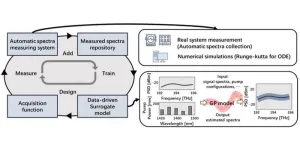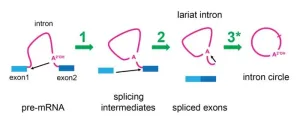(Press-News.org) New research being presented at the European Congress on Obesity (ECO) in Venice, Italy (12-15 May), and published in the International Journal of Obesity, could help explain why type 2 diabetes is more common in men than in women.
“Previous studies have shown that men develop type 2 diabetes (TD2) at a younger age and at a lower weight than women and, overall, men appear to be at higher risk of the condition,” says lead researcher Dr Daniel P Andersson, at the Department of Endocrinology, Karolinska University Hospital Huddinge, Stockholm, Sweden. “One reason for this may be differences in how the sexes’ adipose tissue responds to insulin.
“Adipose tissue is the main organ for the storage of excess energy and this is done in lipids called triglycerides that consist of free fatty acids. When there is excess energy, insulin decreases the breakdown of triglycerides (lipolysis) and the release of free fatty acids to the blood and increases the storage of energy as triglycerides (lipogenesis) in fat cells.
“In insulin resistance, fat cells are less sensitive to insulin and so both of these processes are impaired. This can lead to more fat circulating in the bloodstream, which raises the risk of T2D.
“If the insulin resistance of adipose cells is more pronounced, or severe, in men than in women, this could help explain why T2D is more common in men than women.”
To explore this further, Dr Andersson measured the adipose insulin resistance index (AdipolR, a measure of insulin sensitivity of fat cells, with higher values indicating more resistance to insulin) in 2,344 women and 787 men, average age 44 years and BMI 35 kg/m2.
Men had higher AdipoIR values than women but only when obesity (body mass index 30 kg/m² or more) was present. This was the case both for physically active and sedentary people, in those with and without cardiometabolic disease and in people using nicotine and not.
In a subgroup of 259 women and 54 men living with obesity, the researchers also took biopsies from the adipose tissue to study the effect of insulin on isolated fat cells.
This showed clear differences between the sexes. In men, compared to women, a 10-fold higher concentration of insulin was needed to block the breakdown of triglycerides to fatty acids and the blockage was also less effective in men.
However, the storage capacity of the fat cells was similar for both sexes.
Dr Andersson explains: “In individuals who are living with obesity, you often have an excess of energy available in the body and insulin should decrease the release of fatty acids and increase the storage of lipids in adipose tissue to reduce the free fatty acids circulating in the blood.
“When looking at sex differences, we found that men who were living with obesity had increased adipose insulin resistance and higher levels of free fatty acids in the blood.
“The differences seen between men and women were mainly related to decreased ability of insulin to block the breakdown of fatty acids in fat cells from men rather than sex differences in storage capacity.
“Fatty acids in the bloodstream have effects in the liver, muscle and the pancreas and could lead to further local insulin resistance in these organs, creating a vicious circle that, over time, could lead to development of type 2 diabetes.”
The researchers conclude that in individuals who are living with obesity, adipose tissue insulin resistance is more severe in men than in women, which may partly explain why T2D is more common in men.
END
Do sex differences in how adipose tissue responds to insulin explain why type 2 diabetes is more common in men?
2024-05-11
ELSE PRESS RELEASES FROM THIS DATE:
Poor muscle health is common in people living with obesity – and increases the risk of an early death, Swedish study of people in UK finds
2024-05-11
New research being presented at the European Congress on Obesity (ECO) in Venice, Italy (12-15 May) has found that poor muscle health is associated with a higher risk of an early death in people living with obesity.
Individuals with adverse muscle composition were up to three times more likely to die during the course of the study than those with healthy muscles, a Swedish study of people in the UK concluded.
“We found that just by looking at muscle composition we can predict which individuals with obesity are most likely to die during the next few years,” says lead researcher Dr Jennifer Linge, of AMRA Medical, ...
The American Journal of Health Economics releases a special issue on health equity
2024-05-10
The May 2024 issue of the American Journal of Health Economics collects articles on the topic of health equity. The edition was inspired in part by the COVID-19 pandemic, writes guest editor Mónica García-Pérez, and the ways in which that “health crisis exposed the sources of disparities among different US populations that affect access to health care, quality of care, and final health outcomes.”
Consisting of five papers, the issue devotes particular attention to the topics of “race/ethnicity, ...
Optical power evolution in fiber-optic networks: New framework for better modeling and control
2024-05-10
With the emergence of internet services such as AI-generated content and virtual reality, the demand for global capacity has surged, significantly intensifying pressures on fiber-optic communication systems. To address this surge and reduce operational costs, efforts are underway to develop autonomous driving optical networks (ADONs) with highly-efficient network operations. One of the most important tasks for an ADON is to accurately model and control the optical power evolution (OPE) over fiber links, since it ...
Therapeutic opportunities for hypermutated urothelial carcinomas beyond immunotherapy
2024-05-10
“These results argue that combinations based on immunotherapy may also provide an opportunity for targeting urothelial cancers with low TMB, and provide efficacy superior to classic chemotherapy.”
BUFFALO, NY- May 10, 2024 – A new editorial paper was published in Oncoscience (Volume 11) on April 25, 2024, entitled, “Therapeutic opportunities for hypermutated urothelial carcinomas beyond immunotherapy.”
In this new editorial, researcher Ioannis A. Voutsadakis from Sault Area Hospital and Northern Ontario School of Medicine discusses tumor mutation burden (TMB)—a ...
UC Santa Cruz study discovers cellular activity that hints recycling is in our DNA
2024-05-10
By Rose Miyatsu, UC Santa Cruz Genomics Institute
Although you may not appreciate them, or have even heard of them, throughout your body, countless microscopic machines called spliceosomes are hard at work. As you sit and read, they are faithfully and rapidly putting back together the broken information in your genes by removing sequences called “introns” so that your messenger RNAs can make the correct proteins needed by your cells.
Introns are perhaps one of our genome’s biggest mysteries. They are DNA sequences that interrupt the sensible protein-coding information ...
A retrospective look at Human Computer Interaction - free public lecture by Professor Manolya Kavakli
2024-05-10
Professor Manolya Kavakli is an expert in gamification
Her talk will examine the complex relationship between humans, computers and tech
She will examine how digital developments have the potential to improve lives and modernise industry.
The latest inaugural lecture at Aston University will look at the complex relationship between humans, computers and technology.
Professor Manolya Kavakli will discuss progress so far and offer insights into how to ease into digital transformation for the challenges that lie ahead.
The professor is an expert in gamification, the process of using elements of gaming in non-gaming situations such as learning and training.
She ...
Reducing prejudice in war zones proves challenging
2024-05-10
There are 62.5 million internally displaced persons worldwide, according to 2022 data by the UNHCR, the United Nations Refugee Agency. These individuals were forced to leave their homes but remain in the same country.
Prior research has shown that internally displaced persons often experience prejudice and discrimination, as residents in their new locale fear that the migrants may be insurgents or criminals, or compete for jobs.
Now, a new Dartmouth study involving Afghanistan indicates that changing such attitudes is an uphill battle. Given the decades of fighting there, Afghanistan has had one of the largest populations ...
Chapman professor contributes to breakthrough hemostasis and wound healing research
2024-05-10
A breakthrough study, published in Science Translational Medicine, features a biomedical engineering innovation with the potential to transform trauma care and surgical practices. Chapman University’s Fowler School of Engineering Founding Dean and Professor, Andrew Lyon, is a member of this multidisciplinary, multi-university scientific research team developing platelet-like particles that integrate into the body’s clotting pathways to stop hemorrhage. Sanika Pandit, an alumna of Chapman University, is also among the 15 authors in this research.
Addressing a longstanding gap in surgical and trauma care, this advancement holds potential for patient implementation. Patients ...
Melanoma in darker skin tones: Race and sex play a role, Mayo study finds
2024-05-10
ROCHESTER, Minn. — Melanoma, an aggressive form of skin cancer that accounts for 75% of all skin-cancer-related deaths, is often detected later in people with darker skin complexions — and the consequences can be devastating, a Mayo Clinic study reveals.
While melanoma may be found less frequently in people with darker complexions than fair ones, this potentially serious form of cancer can strike anyone. The study, which consisted of 492,597 patients with melanoma, suggests that added vigilance in early screening is particularly needed for Black men, whose cancers ...
Visual experiences unique to early infancy provide building blocks of human vision, IU study finds
2024-05-10
What do infants see? What do they look at? The answers to these questions are very different for the youngest babies than they are for older infants, children and adults. Characterized by a few high-contrast edges in simple patterns, these early scenes also contain the very materials needed to build a strong foundation for human vision.
That is the finding of a new study, “An edge-simplicity bias in the visual input to young infants,” published on May 10 in Science Advances by IU researchers Erin Anderson, Rowan Candy, Jason Gold and Linda Smith.
“The starting ...




